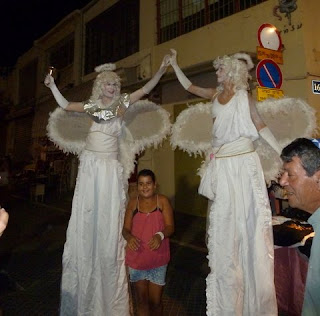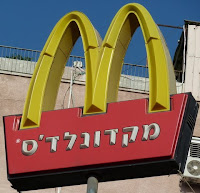
One morning, about a week after our arrival, the doorbell rang at 6:55am. We were all fast asleep. Eden recognized the doorbell (which we had never heard rung before) and jumped up to see who it was. A man outside was repeating something over and over in agitated Hebrew. Eden looked through the peephole and didn't recognize him, so she said...an oft-repeated phrase, “Slikha, ani lo medeberet ivrit” (Sorry, I don't speak Hebrew). That's when the man grimaced and held up our keys. Ah-ha, keys! Apparently we had left them in the door all night. Later, Eden tried to remember what the man had said. So, she looked up “key” in our dictionary. There were eight, yes eight, Hebrew words listed for “key.” She has no recollection of what the man said. Oh well, we'll file that away in our “to be learned when we finally get a Hebrew teacher” folder. (Note: Eden is the one who has been to a key shop and had copies of our keys made. That was accomplished using English and hand gestures. The word for key never came up!)
Keys aside, we are starting to pick up some rudimentary Hebrew. At first, we felt like we'd been dropped on an alien planet. Everyone was talking so fast and the cool fonts used for signs and menus were impossible to read and, of course, there were no vowels (in short, nothing like the prayerbook Hebrew we learned to read in Hebrew school).

After a couple of weeks here, though, and some perusing of our phrase book, we are starting to recognize some words and phrases and to feel like we might eventually connect with people in Hebrew (a bit!). It's still very difficult for us to comprehend conversational Hebrew (too fast and too many unfamiliar words muddying the waters) but we are reading more signs, understanding station/stop announcements on the bus, and saying a few things. Talia is taking a great interest. She heard Eden on the phone say “Yossi lo ba bayit” (Yossi is not home, in reference to our landlord) and asked what it meant. She spent the evening saying “So and so is not home” or “So and so is home.” It was pretty amazing how she picked it up. (Talia will be 5 in October. It's going to be very interesting to follow her Hebrew development alongside her English development. She's still working on mastering the English alphabet.)

Undoubtedly, the key to learning Hebrew (and finding out the right word for “key”) is for us to USE it even if we stumble along and our interlocutors are frustrated because they could easily speak to us in their excellent English (or Russian). If you have ever experienced Soviet customer service, you can imagine that our Russian-speaking grocery store clerk isn't always delighted to wait patiently while we fumble along in Hebrew. That said, we must rush to the defense of the many cashiers and waiters who have really helped us and shown quite a bit of forbearance. So, no excuses, we are going to study and practice!






















































